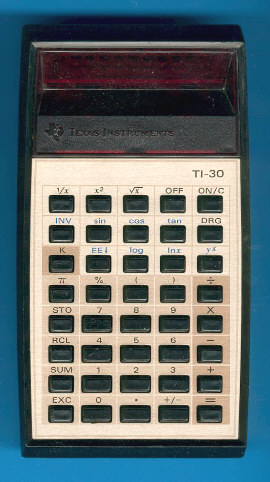
DATAMATH CALCULATOR MUSEUM
 |
DATAMATH CALCULATOR MUSEUM |
Texas Instruments TI-30 (with different keyboard)
| Date of introduction: | June 13, 1976 | Display technology: | LED-stick |
| New price: | $24.95 $13.00 (October, 1981) |
Display size: | 8 (5 + 2) |
| Size: | 5.8" x 3.1" x
1.4" 148 x 78 x 36 mm3 |
||
| Weight: | 4.0 ounces, 114 grams | Serial No: | 2519653 (ATA) |
| Batteries: | 9V | Date of manufacture: | wk 25 year 1978 |
| AC-Adapter: | AC9132, AC9182 | Origin of manufacture: | USA |
| Precision: | 11 | Integrated circuits: | TMC0981 |
| Logic: | AOS - 4 Pending Operations, 15 () | ||
| Memories: | 1 | ||
| Program steps: | Courtesy of: | Christian von Lettow-Vorbeck | |
| Download manual: | |
 At
first glance this TI-30 looks like millions of its siblings manufactured since
the introduction mid of 1976. Nevertheless noticed its owner - fellow collector Christian
von Lettow-Vorbeck - an important difference. We are not talking about the
dozens of variations discovered in the coloring scheme of the keyboard
faceplate, we are talking about a completely different keyboard construction.
At
first glance this TI-30 looks like millions of its siblings manufactured since
the introduction mid of 1976. Nevertheless noticed its owner - fellow collector Christian
von Lettow-Vorbeck - an important difference. We are not talking about the
dozens of variations discovered in the coloring scheme of the keyboard
faceplate, we are talking about a completely different keyboard construction.
Back in 1972 when Texas Instruments introduced the famous Datamath calculator they made use of the reliable Klixon™ keyboard developed already in 1960. These assemblies combine a gold disc panel mounted on a printed circuit board (PCB) and a double-shot molded keytop placed inside a stainless steel mounting frame.
Without doubt this keyboard lasts forever but was far too expensive to compete in the calculator price war mid of the 70's. Texas Instruments introduced with the Exactra 21 already in 1974 a first cost reduction of the original Klixon™ keyboard. Instead of the discrete keytops of the Datamath we notice a molded plastic framing holding all keys in their place but allowing due a clever bending structure some travel of the key. This construction avoided the expensive metal frame and the time consuming placement of the keytops. Later calculators like the TI-1200 introduced in 1975 an even simpler construction using a plastic base plate with some wires to act together with the small discs as a switch.
Within the timeline of the more expensive scientific calculators we found another approach: The whole Slide Rule family of calculators starting with the SR-10 and developing with the SR-11, SR-16, SR-50 plus some others to the SR-52 and SR-56 introduced in 1976 made use of discrete double-shot molded keytops placed either in a metal frame or the plastic housing of the calculator itself. Even the TI-59 introduced May 24, 1977 relies on this construction.
The TI-30 with its simple black keytops was introduced together with the more colorful SR-40 and Business Analyst June 13, 1976. Within the Datamath Calculator Museum we call this family - including the later advanced members centered around the TI-55, TI-57 and MBA - MAJESTIC line in reminiscence to the TI-internal partname (Majestic Mold) of the top housing. All calculators of the MAJESTIC line use either black single-shot or colorful double-shot molded keytops placed in the "Majestic Mold".
But starting today we know: Not all TI-30 use the Majestic Mold!

 It
is obvious that this TI-30 has different keytops compared with the
known ones, they are slightly smaller. The pictures on the right gives a
magnified view and you may notice even a different shape of the upper
surface.
It
is obvious that this TI-30 has different keytops compared with the
known ones, they are slightly smaller. The pictures on the right gives a
magnified view and you may notice even a different shape of the upper
surface.

 Dismantling
this mystery TI-30 reveals a big surprise: The keyboard construction is similar
to the TI-1200 and all 40 keytops are integrated in the molded plastic
part of the housing. The common Majestic Mold is shown for reference and uses 40
discrete keytops. Please notice the already prepared breakthrough in the
Majestic Mold for the ON/OFF-switch of the advanced siblings, e.g. the TI-55
line.
Dismantling
this mystery TI-30 reveals a big surprise: The keyboard construction is similar
to the TI-1200 and all 40 keytops are integrated in the molded plastic
part of the housing. The common Majestic Mold is shown for reference and uses 40
discrete keytops. Please notice the already prepared breakthrough in the
Majestic Mold for the ON/OFF-switch of the advanced siblings, e.g. the TI-55
line.
![]() Why
these differences in the keyboard construction? Due to the parallel
introduction of the (more expensive) SR-40 and the TI-30
engineers had to choose the solution with the discrete keytops, a part combining
the housing top and the colorful double-shot molded keytops would be too
expensive. Up to now we don't know the answer of this question, probably Texas
Instruments started a program to reduce manufacturing costs of the top-selling
TI-30 but manufactured only few calculators in June 1978 in their Abilene, TX
production line.
Why
these differences in the keyboard construction? Due to the parallel
introduction of the (more expensive) SR-40 and the TI-30
engineers had to choose the solution with the discrete keytops, a part combining
the housing top and the colorful double-shot molded keytops would be too
expensive. Up to now we don't know the answer of this question, probably Texas
Instruments started a program to reduce manufacturing costs of the top-selling
TI-30 but manufactured only few calculators in June 1978 in their Abilene, TX
production line.
If you have additions to the above article please email: joerg@datamath.org.
© Joerg Woerner, January 13, 2004. No reprints without written permission.